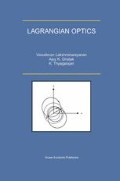Abstract
Variational principles are of great universality and play a major role in the description of natural phenomena. The minimum hypothesis to explain nature has been present in ideas presented by early Greeks whose philosophy seems to be based on the principle that “Nature does nothing in vain”. Such ‘economy’ postulates in the hands of later scientists acted as the foundation for the development of minimum principles such as Fermat’s principle. If one studies the chronological development in the evolution of minimum principles one can get a profound insight into the continuos transformation of a metaphysical canon into an exact natural law.
Access this chapter
Tax calculation will be finalised at checkout
Purchases are for personal use only
Preview
Unable to display preview. Download preview PDF.
References
D.S. Lemons, Perfect form, Princeton University Press, Princeton, N J (1997)
W. Yourgrau and S. Madelstam, Variational principles in Dynamics and Quantum theory Dover, NY, (1968)
C. Lanczos, The variational principles in Mechanics, Dover, NY, (1970)
E. Mach, The science of mechanics, Open court: La Salle, Illinois, (1960). Page 30
R.K. Luneburg, Mathematical theory of optics, Univ. of California press, Berkeley, CA. (1964) page 87.
C. Caratheodory, Geometrische optik, Springer Verlag, Berlin, 1937. page 10.
V. Ronchi, The nature of light, Harvard University Press, Cambridge, MA (1970)
E.T. Whittaker, A history of the theories of Aether and Electricity, Thomas Nelson and Sons, London Vol. 1 (1951); Vol.2(1953)
E.T. Bell, Men of Mathematics, Simon and Schuster, NY, 1937
W.R. Hamilton, The mathematical papers of Sir William Rowan Hamilton, ed. A.W. Conway and J.L. Synge, Vol. 1: Geometrical optics, Cambridge Univ. Press, London (1931); Vol.2: Dynamics, Cambridge Univ. Press, London, 1940
H. Goldstein, Classical Mechanics, Addison Wesley, Cambridge, Mass., (1956)
H. Bruns, Abh. Kgl. Sachs. Ges.Wiss., Math-phys. KL, 21,323 (1985); see also J.L Synge, J. Opt. Soc. Am., 27:138, (1937)
J. Evans and M. Rosenquist, ‘F=ma optics’, Am. J. Phys. 54:876–883 (1986)
D. Gloge, D. Marcuse, Formal quantum theory of light rays, J. Opt Soc. Am., 59:1629, (1969)
H. Busch, Zeitschr. Physik, 81,:974 (1926)
H.A. Buchadahl, An introduction to Hamiltonian optics, Dover, NY, (1993)
Y.S. Kim and M.S. Noz, Phase space picture of Quantum mechanics, world scientific, Singapore (1991)
C. Lejeure and J. Aubert, in Applied charged particle optics, ed. A. Septier, Adv. in Electron, and electr. Physics suppl. 13A, Academic press, NY 1980.
A. Torre, A unified point of view to radiation and changed beam transport, I1 Nuovo Cimento, 112:409 (1999)
Author information
Authors and Affiliations
Rights and permissions
Copyright information
© 2002 Springer Science+Business Media New York
About this chapter
Cite this chapter
Lakshminarayanan, V., Ghatak, A.K., Thyagarajan, K. (2002). Introduction. In: Lagrangian Optics. Springer, Boston, MA. https://doi.org/10.1007/978-1-4615-1711-5_1
Download citation
DOI: https://doi.org/10.1007/978-1-4615-1711-5_1
Publisher Name: Springer, Boston, MA
Print ISBN: 978-0-7923-7582-1
Online ISBN: 978-1-4615-1711-5
eBook Packages: Springer Book Archive

